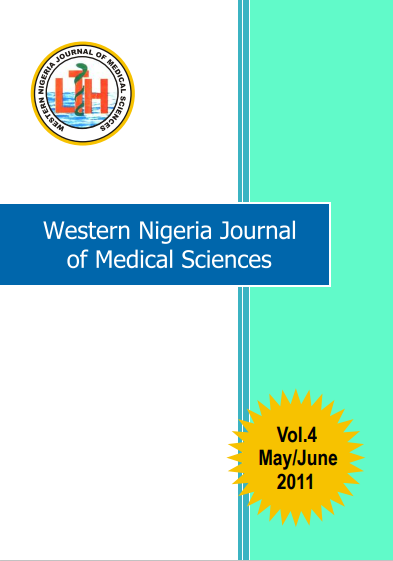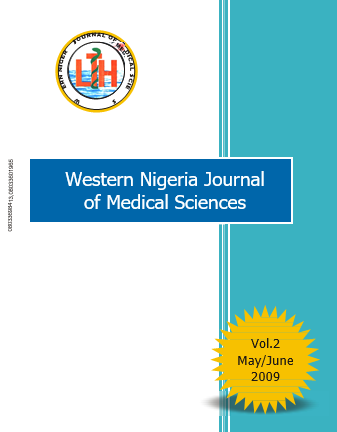Archives
-
Western Nigeria Journal of Medical Sciences
Vol. 8 No. 1 (2025) -

Western Nigeria Journal of Medical Sciences
Vol. 6 No. 1 (2023)Vol. 6 No. 1 (2023): Western Nigeria Journal of Medical Sciences
Published in loving memory of our pioneer Editor-in-Chief, Professor Gabriel Ademola OYEDEJI (1930-2022)
-

Western Nigeria Journal of Medical Sciences
Vol. 5 No. 2 (Jul-Dec) (2022)COVID-19 HAS CHANGED THE WAY WE DO THINGS.
IMMUNIZATION HAS HELPED TO GET US BACK TOGETHER AFTER PERIODS OF SOCIAL RESTRICTIONS.
GET VACCINATED TO PROTECT YOURSELF & ALL OF US
-

Western Nigeria Journal of Medical Sciences
Vol. 4 No. 04 May/June (2011)Coming with developments in technology has been an increasing use of photography in medical work, teaching and research. This is right because one picture can more accurately document and describe a situation than many words. Olaitan in his review paper has captured for us the benefits and uses of clinical photography in plastic surgery including those of the advances in digital photography. He also hints on possible abuses of these developments. On our marks then with cameras, every health worker a photographer. This volume contains 2 papers on birth defects. Elemile et al wrote on cutaneous defects so common ( found in 16.7% of neonates surveyed) and innocent looking that none of the mothers of the affected babies had noticed them .
Joel Medewase on the other hand wrote a case report on a neonate with giant congenital melanocytic nevus so grotesque and extensive that one can only leave to imagination how a mother in a rural area who delivers such a baby would respond and cope with the psychosocial and management problems surrounding the birth of such a baby.
Industrial and labour disputes are becoming common day experience in our hospitals. When they occur, various challenges are presented to clinicians managing seriously ill patients. What does a doctor do if all hospital workers except doctors go on strike?. In many advanced countries such would be most unlikely to happen. Adebami et al analysed neonatal admissions into a teaching hospital during a 4 month such strike to study the effect of the absence of nurses on neonatal mortality and the hospitals work. They found that the predictable rise in mortality which they experienced was compensated for by the survival of some critically ill babies who would have died if not admitted.
Alao et al have contributed a useful data paper on the amniotic fluid indices in Normal human pregnancies in Southwestern Nigeria. Amniotic fluid indices is a non invasive technique of estimating amniotic fluid volume the values of which have diagnostic implications.
This volume also contains a case report by Adekanle et al on Heterotropic pregnancy. The case illustrates the possibility of good and bad fortune being experienced by the same person. A A38-year-old G2P1 woman experienced an intrauterine pregnancy diagnosed 5 weeks after she had a total right salpingectomy because of ruptured ectopic pregnancy. The intrauterine pregnancy which was ultrasonographically estimated at 12 weeks was successfully managed to produce a live infant. Hurray!
Gabriel A.Oyedeji. -

Western Nigeria Journal of Medical Sciences Volume 3
Vol. 3 No. 03 May/June (2010)The opening paper in the present volume of WNJMS is Muhibi's who has sounded a timely warning on the need for private laboratories to pay serious attention to the ethical issues in their practice. This becomes necessary as more and more laboratory scientists are setting up private practices. Issues of standardization quality, legal and other aspects of control have to be properly addressed.
Nigeria has been described as a country with a serious and growing road crash problem which is among the worst in the world. The increasing use of motorcycles particularly for commercial commuter services has been a source of concern in this regard because motorcycles cause many more fatal road crashes than other vehicles worldwide.
In many countries of the world, the use of motorcycle crash helmets has been shown to reduce the frequency and severity of head injuries in accidents. Sangowawa et al in their study of the subject has found that 54.6% of surveyed motorcyclists and 95.5% of their adult passengers in Ibadan did not wear crash helmets properly (securely fastened over their chins) and could possibly have sustained head injuries in case of accidents.
This indicates that health education and legislation, and indeed all health actions must be taken to their logical ends in order to reap their expected benefits. Good laws have to be enforced to be effective.
Conflict and wars have been part of human history from time immemorial. Oluwadiya et al have written an account of gunshot limb fractures sustained in the 1999 Ife/Modakeke war. Their experience emphasizes the need for public hospitals to be equipped with facilities capable of coping with mass casualties in times of crisis. Of course, this is best done in peacetime for although a tear may be an accident, a good patch requires premeditated action.
Olasinde et al have reported on their successful use of free non-vascularised intramedullary splint grafts to bridge the fracture sites in the operative management of severe atrophic limb fracture non-union in two young adults. They recommend the method as a feasible option for the use of surgeons in developing countries in their management of limb fracture non-union.
Olamide et al's paper is a case report on a 9-day-old baby who presented with upper limb deformities (shortened forearms) and had thrombocytopenia features consistent with the diagnosis of TAR syndrome.
Finally, it is to be expected that the health of a pregnant woman and that of the fetus she is carrying would in some way be linked. Adebami et al have shown in their prospective study that the nutritional status and socio-economic classes of mothers are determinants of the frequency of occurrence of foetal malnutrition in their babies.
Well, mothers tend to deliver well babies.
References:
1. Asogwa SE Road Traffic Accidents in Nigeria: a review and a reappraisal Injury 1990; 21: 234-8
2. Oluwadiya KS Pattern of limb injuries resulting from motor cycle accidents in Ile-Ife. A dissertation
submitted to the Natural Postgraduate Medical College of Nigeria May 2001
3. Adesunkanmi ARK, Oginni LM,Oyelami OA,Badru OS, Road traffic accidents to African children.
Assessment of severity using the injury severity score. Injury Int. J . Care Injured 2000; 31: 225-8
4. Bergman AB,Rivera FP, Richards DA. The seattle children's bicycle helmet campaign- Am J Dis
childhood 1990; 144: 727-31.Gabriel A.Oyedeji
-

Western Nigeria Journal of Medical Sciences volume 2
Vol. 2 No. 02 May/June (2009)TWO FRONT BURNERS ON THE AFRICAN MORBIDITY MORTALITY SCALE
The present issue of the Western Nigeria Journal of Medical Sciences contains a review article on The Human Immunodeficiency Virus (HIV) infection and an investigative paper on Home Management of Malaria. These are two preventable diseases that have remained scourged in many sub-Saharan African populations. Decades ago, malaria and HIV infections together with tuberculosis, measles, acute respiratory infections, and diarrhoeal disorders were classified by the G8 / G7 leaders in collaboration with WHO, and UNICEF. Etc as diseases of poverty and targeted for a massive effort.
Ezechi et al have written a review on the Prevention of Mother to Child Transmission of HIV infection. This is a subject of immense importance because the vast majority of childhood HIV infections take place via the mother-to-child vertical route plus the fact that HIV/AIDS burden in Nigeria is the third-largest in the entire world after India and South Africa. Estimates run into 2.86 million for the infected and 1.5million for cumulative deaths. It is obvious that the way to control HIV/AIDS in children is to prevent it in adults. Malaria is a persisting old problem. Since over two decades ago, it had been known to contribute 41% to total under-fives morbidity and 30% to total under-fives deaths in Nigeria. Even now the malaria situation has not improved much. 40% of the world population mostly in developing countries is at risk of malaria with 300 to 500 million yearly infections and an estimated 1- 2 million deaths. Ninety percent of malaria cases and deaths are among the under-fives children in Africa. The plans of WHO for global eradication have given way to the less definitive plans of campaigns and controls. In the meantime, vectors have developed resistance to insecticides and parasites to chemotherapeutic agents. The ROLL BACK MALARIA strategy initiated by WHO, UNICEF, UNDP, and the world bank in 1998 is a package comprising of focus on the highest risk group of mothers and children, preventive treatment of pregnant women, access to rapid diagnosis and treatment at village/community level , better use of existing control tools, interventions like integrated childhood illness management to reduce malaria deaths, improved surveillance and multiple prevention measures including insecticides bed nets and vector control. Double chemotherapy was introduced to combat the rising prevalence of resistance to drugs.
However, today, malaria remains a scourge in Nigeria and similar poor resource countries. The paper by Oyedeji et al on the home management of malaria shows some of the reasons why this is so. If we are able, somehow to combine prompt and correct home treatment of malaria with its preventive measures, we could achieve better control.
Unless we are able to turn policy at the governmental and the sponsoring health agencies levels to practice at the village/community and home levels, we can be accused of professing prevention very much but practicing it very little. Principally too, we must address the underlying poor socio-economic conditions which have turned HIV and malaria infections into diseases of poverty. After all, it has been stated that poverty of the spirit and of resources remains the antecedent risk factor for preventable disease. Of course, the future breakthrough to the discovery of effective and affordable vaccines for these infections is the real hope; but should the suffering and deaths continue while we wait for the vaccines?
Gabriel A. Oyedeji -

Western Nigeria Journal of Medical Sciences
Vol. 1 No. 01 May/June (2008)I thank God for the privilege to write the editorial comment on this maiden issue of the Western Nigeria Journal of Medical Sciences (WNJMS). I heartily congratulate the authorities of the Ladoke Akintola University of Technology (LAUTECH) Teaching Hospital for floating the journal and appreciate their commitment to the same. Some may wonder why we are floating yet another journal in health sciences with several already existing in the academic market. The base of knowledge is continuously deepening and its space widening. The WNJMS intends to cut a niche for itself within this deepening base and widening space to disseminate the results of good quality research catering to the interest of international readership and especially of relevance to those in similar socio-economic environmental, geographical and cultural settings with ours. It has the promotion of excellence as its aim and hopes to become a good medium for the cross-fertilization of academic ideas.
The present issue contains articles spanning some areas of medicines. There is an invited article on laboratory diagnosis and monitoring of HIV infection. In addition, there are original investigative research articles on maternal tetanus immunization aspect of community medicine, the relationship between age and pregnancy outcome in obstetrics, cancer registry aspect in oncology, mental health and family support in family medicine, and peadiatric limb injuries in surgical trauma. There are also interesting review papers on chest medicine and the place of maggot debridement therapy in wound management as well as a case report on primary angiosarcoma of the breast.
Gabriel A. OyedejiEditor





